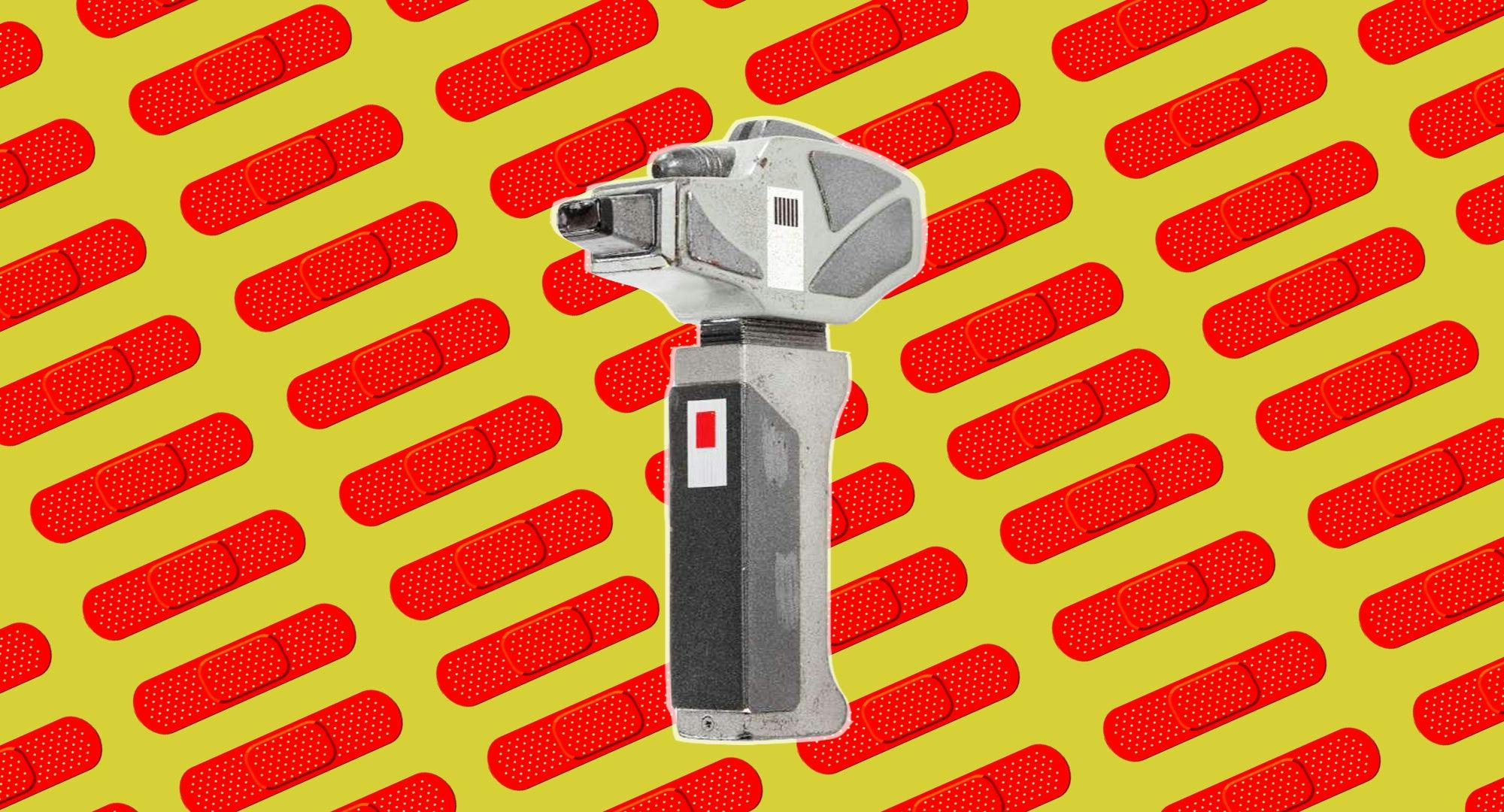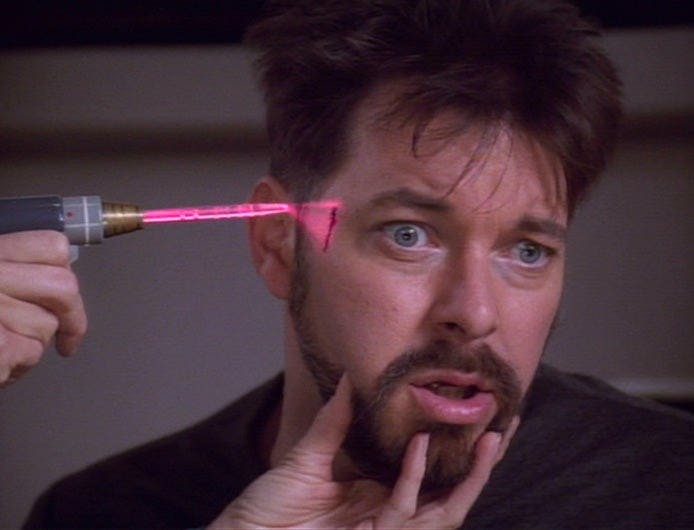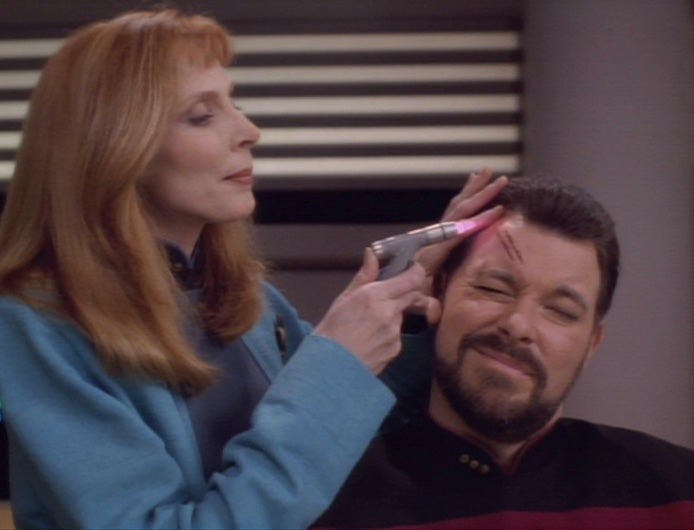Published Apr 30, 2019
Researchers Take Steps Towards an Iconic "Trek" Medical Device
Dermal Regenerators could be on their way.

StarTrek.com
How've you been treating yourself lately? Any cuts or abrasions? Have you had to kiss any skinned knees? Gotten a scratch from a temperamental cat?

StarTrek.com
If you've had to reach for a bandage since the year began, don't worry — you're not alone. In fact, in 2018, the US spent close to $774 million on self-sticking bandages (colloquially, you might know them as Band-Aids) of various kinds. And we needed them! Open wounds must be covered up so they can heal properly; you don't want anything infecting the dermis —that’s your skin— while it grows new layers to replace what was lost in injury, and that takes time.
Obviously, a paper cut heals faster than a nasty slip of the knife, dicing veggies for dinner. And even that heals faster than a larger wound sustained in a high impact accident. The larger the wound, the longer it takes to heal. If your skin is too damaged to heal by itself (or with the aid of stitches) doctors might try taking a graft of healthy skin from another part of your body to replace the injured spot. But it's a painful process, leaving you with just that much more dermis to regrow. Taking healthy skin from somebody else isn’t an option either; your immune system — zealous defender that it is — might mistakenly treat the new graft as hostile and make you terribly sick as it tries to fight off the invader.

StarTrek.com
Of course, in Star Trek’s 24th century, any ship's sickbay, home medicine cabinet, or halfway decent field medical kit includes a trusty dermal regenerator. It's the ultimate point-and-click solution: just aim it at the wound and turn it on, and its gentle beam of healing light magically closes the skin up.
How does it do that? The name is a dead giveaway. A dermal regenerator seems to literally regenerate your dermis by prompting new skin cells grow in the beam’s wake. It's the perfect solution.
While you won’t find the 24th century's answer to the Band-Aid in a drugstore near you anytime soon, we can at least see it on our long-range sensors. Researchers at the Wake Forest Institute for Regenerative Medicine, led by assistant professor Sean Murphy, developed something they call a "Mobile Skin Bioprinter" in June 2018 (the paper was just published in Nature's journal Scientific Reports in February 2019).
Let's say you've got a big, bad scrape that needs healing, and you call the Wake Forest team into action. First, they take a small sample of healthy skin from you and put it in a jar where it can grow, independent of your body. Once lab techs have a nice supply of healthy, happy skin cells, they mix them into a life-sustaining hydrogel and pour it into the Bioprinter — which looks like a couple of microwaves combined with a 3D printing arm and a disembodied robot head, all bolted to a rack on wheels. They roll it over to your bedside, where the robot head scans your scrape, getting a laser's-eye view of all its contours and ridges. The machine proceeds to figure out exactly where and how to place layers of new cells so they'll match the structure of the skin that was originally there. Once the scanning is done, the Bioprinter's printing arm gets to work putting down the cells it was given, layer by layer.

StarTrek.com
Initial tests were performed on animal test subjects, but the results were highly encouraging: the Bioprinter technique closes wounds faster, causes less puckering from scarring, and generates new skin quicker. The next step for the Wake Forest team is to start clinical trials on humans.
Even as testing progresses, it’s important to note that this isn’t a magical cure-all. However, The benefits would be obvious and enormous, especially to soldiers and burn victims, who don't have a lot of choices when it comes to skin grafts. The dermis cells left in the machine’s wake are right where they need to be in order to start growing, connecting to the surrounding tissue, and healing the wound. Think of it like patching a crack in the sidewalk with fresh wet cement; with a little time you won’t even be able to tell the crack was there in the first place. As an added bonus, because the replaced skin cells come from their own bodies, the Mobile Skin Bioprinter leaves patients with no chance of rejection by their immune system.
The Mobile Skin Bioprinter isn't exactly a handheld device that heals wounds at the touch of a purple beam of light like Trek’s dermal regenerator, but it's getting there. Future versions will no doubt be smaller and sleeker. The real challenge will be figuring out a way to stimulate existing cell growth within the wound, instead of growing replacement cells in a jar and layering them on humans like spackle. Once we catch up with Star Trek and that technology arrives we — and the faces of first officers everywhere — will be far safer from harm.
Dr. Erin Macdonald Explains Transporters
Jon Sung is a dad, podcaster, and copywriting phaser-for-hire to startups and ventures all over the San Francisco Bay. His extensive and baffling internet presence begins at flavor.country. Follow him @ferociousj.
